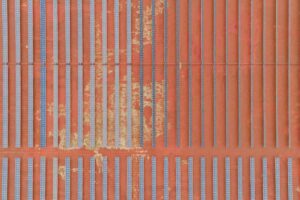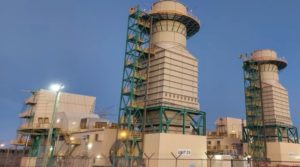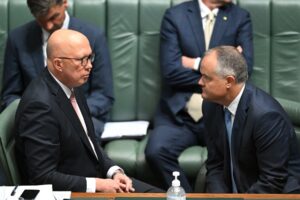Remember how the federal Coalition government described Labor’s 50 per cent renewable energy target for 2030 “as reckless” and an “economy wrecker.”
Energy minister Angus Taylor even went so far as saying that that level of renewables would “de-industrialse the economy”. Now, it turns out, Taylor is relying on Australia reaching 50 per cent renewable energy by 2030 to deliver the only physical cut in emissions that he expects to achievein the next 10 years.
The extraordinary admission is included in the latest update on the country’s emissions outlook, which Taylor – who doubles as emissions reductions minister – says outlines “to the last tonne” how the Coalition is tracking towards the government target of cutting overall emissions by 26-28 per cent by 2030.
The document says that target will be exceeded, but only through the use of an accounting loophole dammed by climate scientists and rejected by more than 100 countries at the climate talks in Madrid. The other major source of reductions comes through the dramatic switch to a level of renewables that the Coalition insisted in the last election campaign was impossible and would kill the economy.
The document, titled Australia’s emissions projections 2019, assumes that the country’s main grid reaches 51 per cent renewable by 2030 after doubling the installed capacity of rooftop solar, large scale solar and wind energy over the next decade.
South Australia, a state the Coalition has sought to ridicule for its growing dependence on wind and solar, is assumed to source 96 per cent of its electricity supply from those very technologies by 2030. The state Liberal government has a target of “net 100 per cent” renewables by 2030.
Taylor has repeatedly said there is already too much wind and solar in the grid, and his conservative colleagues have insisted that modern economies cannot be powered by “intermittent” wind and solar.
The assumptions in the government document confirms that almost everything the Coalition has said in its campaigns against Labor’s target has been complete bollocks. Indeed, it turns out that the only reduction in Australia’s physical emissions are delivered by a policy it tried to kill (renewable energy target) and via technologies the Coalition claimed would kill the economy.
The 50 per cent target was hardly a stretch target, given the expectation of state demand, corporate demand and rooftop solar, and this document still underplays some of the take up of large scale solar. But it also makes you wonder if Labor will now have the courage to defend and re-embrace those very same targets that it is now being pressured to drop.
Taylor, a prominent anti-wind campaigner before entering parliament, is predicting that the amount of wind energy will nearly double over the next decade to 18GW despite the lack of any federal subsidies. A third of the coal fleet is predicted to retire by 2030, and one tenth of the gas fleet.
The forecast uptake of renewables is based on state-based targets in Victoria and Queensland being met, or nearly met in the case of Queensland, but even Western Australia reaches 55 per cent renewables by 2030. The only sector dragging its heals is NSW (40 per cent) and off-grid generation (18 per cent).
The uptake of renewables is the only really good news in the emissions forecasts, because the federal Coalition government prediction is that emissions rise in almost every other part of the economy – including agriculture, transport, direct combustion and fugitive emissions.
The government only reaches the bottom end of the 26-28 per cent Paris target by counting “excess credits” from the Kyoto targets to 2012 (when Australia was allowed to increase its emissions significantly) and to 2020, when it was required to achieve only a minor decline.
Climate experts say using these surpluses is a fraud, and its use is opposed by most other countries. Without the surplus, Australia would fall 365 million tonnes short of its 26 per cent target, and 411 million tonnes short of the 28 per cent target. (These targets are a “carbon budget” of cumulative emissions over the decade to 2030).
In terms of annual emissions, the government’s own actions will result in only slight falls by 2030 from current levels, and will be show minimal reductions from 2000 levels. The 2030 target shows a reduction of just 21 million tonnes in annual emissions by 2030, even after 49 million tonnes are cut from electricity, thanks to the uptake of renewables that the Coalition had said was not possible. Emissions in virtually every other sector are predicted to rise.
The 2030 target shows a reduction of just 21 million tonnes in annual emissions by 2030, even after 49 million tonnes are cut from electricity, thanks to the uptake of renewables that the Coalition had said was not possible. Emissions in virtually every other sector are predicted to rise.
“These declines are driven by the projected continued decarbonisation of electricity generation across the country, including the country’s largest market, the NEM (National Electricity Market),” the report says.
“Large deployment of renewables, in particular rooftop solar, form a growing share of generation in the NEM.” Last year, the document predicted renewables would deliver only one third of the emissions reductions it predicts now.
The document says the overall predictions do not include any further emissions reductions that could be achieved through the switch to electric vehicles, another contentious point during the election campaign.
Labor wanted electric vehicles to reach 50 per cent of new vehicle sales by 2030, but the government said that would “end the weekend” and increase costs.
The Coalition is expected to unveil its EV strategy in 2020, but past forecasts from the government have assumed that the 50 per cent target it had decried would be reached anyway. The latest document assumes a 19 per cent share for electric vehicles in new car sales by 2030, but does not take into account any new policies.












